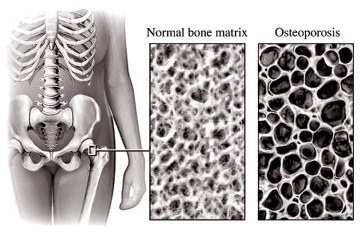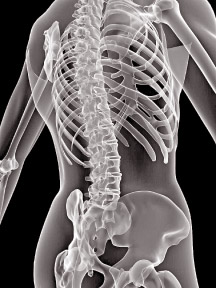|
Health Watch
Arm against osteoporosis
Senali S. PERERA
Most women seem frightened of the word itself: Osteoporosis. Will I
have to face it someday? Others seem to have little or no idea about
what it is. What is osteoporosis? Why do women have to be frightened of
it? Dr. Harindu Wijesinghe, Consultant Rheumatologist in an interview
with Daily News Health Watch
 provides
answers to many of such questions, shedding light on common confusions. provides
answers to many of such questions, shedding light on common confusions.
According to the International Osteoporosis Foundation, it is
estimated that currently, over 200 million people worldwide suffer from
this disease. “Ageing of populations worldwide will be responsible for a
major increase of the incidence of osteoporosis on postmenopausal
women.”
“Osteoporosis is a disease of bones,” Dr. Wijesinghe said. “It makes
your bones weak. Because of the decreased strength of the bones,
fractures can happen easily.” Dr. Wijesinghe made it clear that
osteoporosis does not involve joints. “It is false if you assume the
pain in your joints will turn into osteoporosis. No, it does not happen.
Osteoporosis is plainly a disease that involves your bones rather than
joints.”
Silent disease
Osteoporosis does not cause symptoms until you break a bone. “It is a
silent disease. Most commonly fractured parts are forearm, the spinal
column and the hip. A person with osteoporosis may break their bones,
falling from a standing height.”
He also said that very rarely, fractures can occur without a person
falling. In sudden movements such as sneezing, these fractures can
happen. But it is very rare.
How do I know if I have osteoporosis? Since, there are no symptoms
shown, Dr. Wijesinghe said that the disease can be diagnosed through
screening. The best test is a bone density test called the “DXA test”.
It is a special kind of X-Ray. People with ‘risk factors’ are
recommended to face this test.
The main risk factors are,

* Premature menopause in women.
* Being very thin.
* Smoking.
* Less active lifestyle.
* Family history of osteoporosis.
“Apart from this, it is recommended for women older than 60 to get
themselves tested for osteoporosis,” said Dr. Wijesinghe. That is
because women in this age group have the highest risk of osteoporosis.
Did you know that our skeleton is being replaced by new bones several
times during our lifetime? Osteoblasts are one type of bone cell (out of
three) that is found in bone tissue. They are bone forming cells (make
bone). It deposits bone even as another bone cell, osteoclasts, breaks
it down. This process in which the bones are being remodeled is called,
the bone resorption formation cycle.
Common among women
Up to age 30, a person’s bones are lay down actively. But after that,
the born absorption formation cycle is reversed. Therefore, more bone is
absorbed and because of this, the bone mass tends to reduce. “In
females, when they go through menopause, their bone absorption - the
removal phase of your body’s bone remodeling process- is faster than
normal,” he said.
Therefore they rapidly lose bone mass. “So now you know why females
are more prone to osteoporosis than males.”
Out of the fractures that may happen due to osteoporosis, “the
initial fracture is usually the forearm,” said Wijesinghe. Usually, this
heals by itself.
But if not treated properly, a person might face the next big
fracture: the spinal column. It has been shown that an initial fracture
is a major risk factor for a new fracture. This causes severe pain and
might cause stoop position where you will lose your height.
According to Wijesinghe, the worst fracture that happens due to
osteoporosis is the hip fracture. Elderly people tend to be bed-bound
because of this and the consequences may lead their life span to be
reduced. How do I prevent osteoporosis? “Firstly, the simplest way is to
prevent a fall. If you don’t fall, there is no chance of breaking
bones,” said Dr. Wijesinghe.
To do that:
|

Dr. Harindu Wijesinghe |
* Make sure all your rugs have no-slip backing to keep them in place.
* Tuck away electrical cords, so they are not in your way.
* Light all walkways well.
* Watch out for slippery floors.
* Wear sturdy, comfortable shoes with rubber soles.
* Have your eyes checked.
* sk your doctor to check if any of your medicines might make you
dizzy or increase your risk of falling.
Calcium intake
It is also important to achieve high density of Calcium in young
ages. (Because as mentioned earlier, a person reaches his/her peak bone
mass at age 30.) How much Calcium a person needs per day depends on how
old he or she is. “A normal person needs 800mg to 1000mg per day from
the diet,” said Dr. Wijesinghe. “It is also important to obtain
sufficient amount of Vitamin D. This, you obtain through food as well as
sunlight.”
A person with osteoporosis needs 1500mg of Calcium which he or she
obtains through diet and directly through medicine. Too much Calcium can
cause heart diseases and stones. But how can a person’s Calcium intake
be too much? “This happens when you take too many Calcium tablets. But
under a physician’s supervision, this can be prevented,” said Wijesinghe
further.
Once low Calcium and Protein levels which make the bones brittle and
weak re identified, additional amounts of Calcium and Vitamin D should
be given through tablets and modified diet. Among these are
Bisphosphonates which enables bones to take up more Calcium and
therefore making them strong. This can be taken weekly or monthly
through tablets. Or else, it can also be taken once a year through
injection.
What can you do to keep your bones healthy?
* Eat foods with lot of Calcium.
* Eat foods with lot of Vitamin D
* Be active for at least 30 minutes, most days of the week.
* Avoid smoking.
* Limit the amount of alcohol you drink.
Types of food
Foods rich with Calcium are soy milk, kale, broccoli, milk, cheese,
almond, yoghurt, cereals, beans, tofu and green leafy vegetables. Foods
rich with Vitamin D are canned tuna fish, cod liver oil, ready-to-eat
cereals, cooked salmon, canned sardines, mackerel and eggs.
Daily exercise is always important. “Walking is a recommended
exercise,” he said. It makes your muscles strong; increasing balance and
thus, your chances of falling is reduced. It also strengthens bones.” To
make bones strong, Dr. Wijesinghe recommended weight bearing exercises
such as walking, jogging, dancing, Tai Chi and yoga. These also help to
increase balance.
For muscles, he recommended resistance training -using light
dumbbells and resistance bands- and sports like swimming.
Daily exercises - a must
“Encourage your children and yourself to exercise daily rather than
staying indoors all the time,” and to eat healthy foods with Calcium and
Vitamin D rather than drinking soft drinks and eating fast food.”
Making yourself healthy is a process that you should work on since
childhood. But you are not too late to start afresh today. Because as we
always here they say, “Prevention is better than cure.” Because saving
your life no one’s responsibility but yours alone.
Breast cancer:
Causes and treatmnet
Ishara JAYAWARDANE
The death of a person due to cancer is particularly distressing
because the enemy comes from within. If it is a person who threatens
your life at least you can fight him off. However there is hope with the
many advances in medical science. Dr.Neomal Perera of Lanka Hospitals
talks to Daily News Healthwatch on types of cancer with special emphasis
on breast cancer.
|

Dr.Neomal Perera |
“Incidence wise cancer is increasing. Compared to 1980 and 2000, for
the last 20 years the number of a cases diagnosed with cancer has
doubled. The number of deaths during these 20 years has got doubled. So
it is on the increase. In the 1980’s cancer was the sixth leading cause
of death. By year 2000, it has become the fifth.
As the health sector in Sri Lanka are targeting more communicable
diseases and as those things are going down, without our knowledge these
non communicable diseases are going up. One interesting thing which we
have seen is because of the health education, certain cancers like oral
cancer which were due to chewing of betel and alcohol and smoking it has
gone down. Those days it as the commonest cancer and we see a more
westernized picture in Sri Lanka as well. So breast cancer has become
the number one cancer,” said Dr. Perera
When you compare both males and females breast cancer is the
commonest. When you take breast cancer, although we know it affects the
females there is a one percent chance that it could affect the males as
well. The breast cancer is mainly because of the female sex hormones.
The males also have sex hormones - low quantity but for some reason
males also can get it.
Female hormones
“Breast cancer is mainly because of the female hormones. So if women
are exposed to these female hormones they are prone to get breast
cancer. One way they can get exposed for a longer time is if they attain
puberty at an early age. Those days we have heard puberty was around
12-14. But now we hear girls attain puberty earlier than that - 8-9
years. It could be because of the westernized food which contain lots of
hormones. And also if the menstruation gets prolonged even after
menopause or if the menopause is quite late, let’s say in their 60’s or
if someone takes artificial Hormone Replacement Therapy to prolong their
menstruation they get exposed to this breast cancer.
They are at a high risk of getting breast cancer. The way to stop
this breast cancer is, if they get pregnant earlier in their life. You
can reduce the number of hormones exposed on the breast that has a
reversal effect. The incidence goes down if they get pregnant.”
Having multiple pregnancies and breast feeding are factors which
prevents a person from getting breast cancer. “Even hormone
contraceptive pills, if you take it for a longer time maybe 7-8 years or
up to 10-15 years, then still you are prone to getting breast cancer.
Hormone tablets can be taken as oral contraceptive pills and some people
get it injected once in three months. That also increases the risk.
The international worldwide data it says five to eight percent of
breast cancers can go in the family. In Sri Lanka fortunately we see at
a lower percentage, 2- 3 percent can be familial or Genetical but
worldwide it is five to eight percent. In Sri Lanka the genetic
predisposition is a bit low.”
When we see the age of breast cancer in the developed countries we
see the elderly population getting breast cancer 55 - 65. “ But in Sri
Lanka we see it more in the younger generation- 40-45. It affects the
Sri Lankan economy because this is the prime age where the women are
having their children, starting their careers it affects their families
so there is an impact on the Sri Lanka economy.
To avoid this, the best thing is to do breast self examination.
Examine their breasts on their own. It is economically not cost
effective to have a mass scale screening program. In American and UK
they have mass scale screening programs using mamographies. In those
countries over 50, all women have to do a mammography.
But in Sri Lanka we can’t do that because it is not economically cost
effective. So the way to detect the cancer early is to ask women to
examine their own breasts once a month. They should start when they are
25 years old and examine their breasts until they die, every month. The
ideal time is soon as the finish their periods or menses.
That is the best time to examine their breasts. If they notice a lump
or they squeeze their nipple and see blood coming out or some lumps in
the armpits, those are early symptoms of breast cancer. A painful lump
is probably not a cancer. That is myth people thinking that if it is
painful you should go ahead. Actually the cancers are painless. You
should not wait until you feel pain because the cancer will grow without
your knowledge. Painful lumps are usually benign and not cancers.
Investigation
So once we see a lump we must investigate. We investigate in three
ways - Clinically we examine and see, then we do imaging- take a
picture. We take the picture in two ways - one is mammography and the
second is the scanning. Both ways we do it and see if we can get some
information out of those things.
The third thing is the needle test. We pass a needle and take some
cells put it on a slide and see. So in three ways, once we confirm it is
cancer, we tell the patient and start the treatment. Treatment wise, in
the early stage surgery is a must. In early stage sometimes without
removing the entire breast if we catch it early, we can do a breast
conservation where we don’t remove the entire breast but we remove the
lump. But in breast conservation the risk of having a recurrence is
high.
The tumor can recur again. Because we don’t remove the entire breast
we remove only a part. The next way is to remove the entire breast. But
the price the patient has to pay is they get deformed. So to avoid that
we have the surgical technique of reconstruction, where we re- construct
the entire breast using either a silicon influx or the fat from their
abdomen and put it there or use the fat from the back and reconstruct
the breast as it is.
This is very important and popular in Sri Lanka as well as we see
younger women getting breast cancer and they have the option of getting
it reconstructed after removal. So one we remove we decide if they
patient should get chemotherapy or radiotherapy. The important message
is if we pick up early we can cure. If it is an advance tumor cure rates
come down gradually and if is an advance tumor I would say survival rate
is two years.”
Oral cancer
The second commonest cancer is oral Cancer. It was the first those
days now it has become the second commonest cancer. Oral Cancer there
are very clear risk factors like Smoking, betel chewing and alcohol.
However we see certain patients without being exposed to these, still
they get it. So that is a very small percentage.
But the sad part is although they know that this is a cancer they try
to hide it because they can’t get over their habit. They know there is a
tumor and that it is growing. So we see a lot of advanced cancers in the
oral. The sad part is there are a lot of important organs very close
together. If we do a surgery we have to take parts from the adjacent
organs as well. For example if there is a small lesion in the cheek
sometimes when you do the incision it might touch the tongue, so part of
the tongue we may have to remove although it is not affected.
Workplace Safety and Health
Prof Hemantha Wickramatillake, Professor
Occupational and Public Health,
Johns Hopkins Perdana University, Malaysia
The Universal Declaration of Human Rights, adopted by the United
Nations General Assembly in 1948, recognizes the right of all people to
just and favourable conditions of work. Unfortunately, millions of
people around the world are employed in conditions that deprive them of
dignity and value.
|

Prof Hemantha
Wickramatillake |
It is estimated that workers suffer 250 million accidents every year,
with 330,000 fatalities. Further avoidable suffering is caused by 160
million cases of occupational diseases and an even higher number of
threats to workers physical and mental well-being. The economic losses
are equivalent to 4 per cent of the world’s gross national product; in
terms of shattered families and communities, the damage is incalculable.
Policy makers and employers need to ensure that the provision of a
safe and healthy working environment is a key consideration in all
investment and production decisions, and the workers are involved in
those decisions. This is an enormous task, for Governments, employers
and workers alike.
Situation in Sri Lanka
The situation in Sri Lanka is no different to many developing
countries. With an estimated, current, work force of around 8 million
people, the legal safety and health cover is only for, around 3 million
workers in the formal sector. This too is restricted to those who come
under the Factories Ordinance.
As a result of ILO’s and the present Government’s concern ( President
Mahinda Rajapaksa was one time the Minister of Labor), a new law named
‘Safety, Health and Welfare” is to be enacted in Parliament during the
course of this year.
This new law will bring about many changes and a new era in safety
and health, with stringent regulations to safeguard the safety and
health of a huge population. Some of the important features are that it
will provide a legal cover for all workers in the country, whether they
are in the formal or informal sector and this will, also, include the
public sector. |







